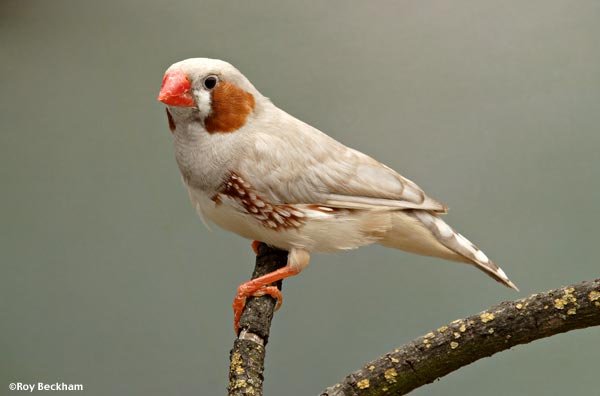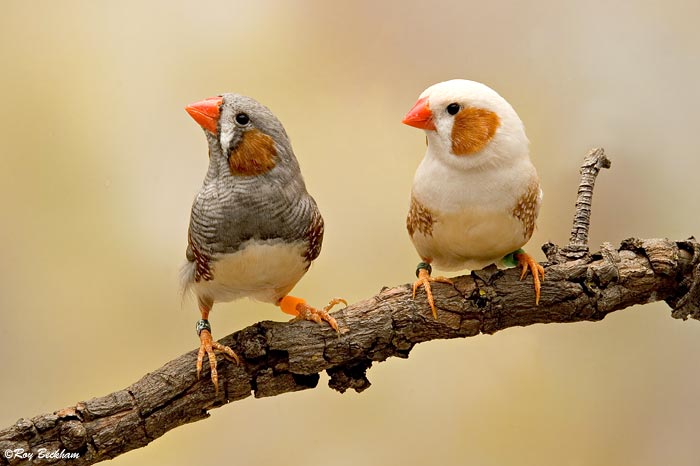|
Mutation Effects
Inheritance: Co-dominant (Allele of the European Isabel)
Male: The Florida Fancy mutation works to suppress all the Black coloration (eumelanin) on the bird. This creates a nearly all white bird with the orange markings remaining at full strength. There will often be some orange lacing in the wings. If not a pure white, there can be a hint of a silver color when seen in certain light. The belly will often be a rich creamy buff color.
Female: Like the male, the gray and black coloration has been eliminated and a silvery white color will remain. The buff belly and tail, also present in the males, is often more rich in the hens. The orange lacing however is often not as pronounced as in the males.
Flight of Florida Fancies, splits and Black Breasts (click to view)
The enigma of the Florida Fancy
The American Florida Fancy mutation is a co-dominant mutation that is an allele of the European Isabel mutation which is a autosomal recessive mutation. I conducted a number of breeding tests to show the relationship of these similar mutations. The results helped clear some of the confusing results in breeding and helped identify the color variations and breeding results we were getting in the U.S. with our birds and imported birds. Read the story of the FF and Isabel mutations
Identifying Splits
Male: When Florida Fancies are crossed with normal Gray Zebras, the result is a color in between the two - a silvery diluted gray. The normally black markings are reduced to the point that they are almost the same color as the body color. These birds have been called 'Silver Isabels' by Garrie Landry of Franklin, LA (zebrafinch.com) and more recently these birds have been referred to as Florida Silvers. With their diluted gray color and orange markings at full strength, they are often confused with Recessive Silvers, but there are some differences. Namely, the black markings on the Florida Fancy split or silvers are reduced to nearly the same color as the base gray. In Recessive Silvers the tear mark and breast bar are reduced in color, but are quite prominent against the diluted base color. The orange lacing of the wings can also be seen in the Florida Fancy splits as well as the buff coloring of the belly.
Female: Like the male, the female shows a silver gray color with the normally black markings of the normal reduced to the same color as the body. The females will often be lighter in comparison to the males in regards to this silver color. The belly will have the buff coloring of the Florida Fancy, but does not appear as rich.

Single Factor or split Florida Fancy now referred to as Florida Silvers.
Combinations
The Florida Fancy is often combined with other mutations that enhance or extend the orange markings of the male. Very little change can be achieved with combinations on the females since all the gray and black has been eliminated and they do not have any orange markings. The males are very striking when combined with mutations such as the Black Breast which allows for an extension of the cheek patches as well as some enhancement of the orange lacing in the wings. These are often referred to as 'Phaeos', which is short for phaeomelanin the pigment responsible for the orange color in Zebra finches. Florida Fancies can be combined with Orange Breast to develop an orange breast bar, which shows that it was only the pigment of the marking that was suppressed and not the bar itself. The Florida Fancy can be combined with the Black Face mutation, but by itself has no effect on the appearance of the male or female. If combined with the Orange Breasted mutation as well then the face area and extended breast bar will show as orange. The ultimate combination for Florida Fancy breeders seems to be the combination of all those mutations listed; the Florida Fancy, Black Breasted, Black Face and Orange Breast. This four mutation combination can result in a male bird that has an all orange head with that orange color extending from the beak down the breast and on to the vent with lots of orange lacing on the wings. Some photos I have seen of birds produced in Europe are outstanding. I almost did not recognize the combination as a Zebra finch.

Florida Fancy Black Breasted. Commonly called a Phaeo
The Florida Fancy mutation is in conflict with the Black Cheek mutation. One mutation is working to increase the amount of gray and black markings while the other is working to reduce and eliminate them. As noted above, a combination with the Black Face mutation alone has no effect on the results of the Florida Fancy and can even be difficult to identify. Combinations with the Pied mutation should be avoided since the white blotches of the Pied would diminish the beauty of a white based mutation. Combinations with the CFW would certainly result in a dilution of the orange markings and should be avoided as well since I can see no positive results from that combination. I'm not sure that the Florida Fancy has been combined with the Penguin mutation, but again, I can see no benefits from working towards that combination.
Florida Silver Black Breasted -same as above (click to view)
Florida Silve Black Breasted (click to view)
Notes
The Florida Fancy was discovered and developed in the United States in the early 1970's. Visually, they appear to be the same as the European and Australian Isabels, but the method of inheritance is very different. Both of the other continent's mutations are recessive traits while the US Florida Fancy is a co-dominant trait. The European Isabel and the American Florida Fancy are closely related. Read the results of my multi-year project to unravel the relationship of the Florida Fancy and the European Isabel.
The name Florida Fancy was coined by Hazel Kipp of Tarpon Springs, Florida. The name Isabel used by the Europeans and Australians is a name used for a brownish-yellow color that is "said to be named from the Spanish princess Isabella, daughter of king Philip II., in allusion to the color assumed by her undergarments, which she wore without change from 1601 to 1604, in consequence of a vow made by her." Websters Dictionary 1913.
|












